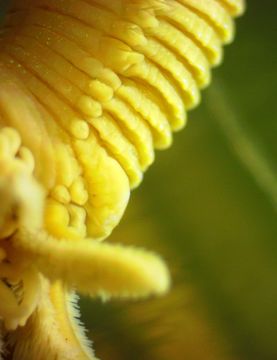Image of Paralvinella palmiformis Desbruyères & Laubier 1986

Description:
In this view of the first several segments, dorsal is right, ventral is left, and the head is downward. The bumps along the sides of the segments are the parapodia. Setae are projecting from the parapodia although they cannot be seen clearly on all the segments. The first chaetigerous segment (setiger) is partly hidden behind the head and gill structures. The parapodia and setae on setigers 2 and 3 are clearly visible. Chaetigerous segment 4 is swollen on thedorsal side and at that point the location of the parapodia shifts in the ventral direction. Setae can be seen projecting from several segments. Note that the parapodium and setae on setifer 7 are not evident. The species description says that the setae are much modified on setiger 7. If this modification is like that seen in other paralvinellids such as P. sulfincola, the setae are much larger, thicker, darker, and curved backward (photo). Also note the complete lack of a ventral (neuropodium) lobe on the parapodia and the lack of neurosetae.
Included On The Following Pages:
- Life (creatures)
- Cellular (cellular organisms)
- Eukaryota (eukaryotes)
- Opisthokonta (opisthokonts)
- Metazoa (Animal)
- Bilateria
- Protostomia (protostomes)
- Spiralia (spiralians)
- Annelida (segmented worms)
- Sedentaria
- Terebelliformia
- Alvinellidae (Pompeii worms)
- Paralvinella
- Paralvinella palmiformis
This image is not featured in any collections.
Source Information
- license
- cc-by-nc-sa
- copyright
- Rosario Beach Marine Laboratory
- provider
- Invertebrates of the Salish Sea
- original
- original media file
- visit source
- partner site
- Invertebrates of the Salish Sea
- ID


